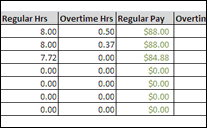
If the employee is not eligible for overtime, select “Exempt.”ģ. However, these rates are just a guide only: overtime rates may vary depending on workplace agreements or industry. This calculator can help with overtime rates that are 1.5 and 2 times the rate of the employee’s base pay. Then add the employee’s base hourly pay rate, and select their overtime rate.

Note any employee who works in excess of 38 hours per week or 7.6 hours in a day must be paid overtime in Australia. If an employee is eligible for overtime pay, select the employee’s overtime rule-whether they receive overtime pay for hours worked over 7.6 in a day, or 38 in a week.
Calculate hours with lunch break how to#
This might not be an easy task, yet not impossible.Here are the step by step instructions on how to use the timesheet calculator:įor each employee, select the weekly timesheet to see one week of time entries or use the bi-weekly timesheet to see two weeks’ worth of time entries and add the number of days worked.
Calculate hours with lunch break code#
You might then try to adapt the code for the workhours to also handle the lunch break.

You might see a simpler option here - Sum DateDiffWorkhours on a specific status - #2 by oskars.laganovskis That script would need the public holidays fed as an additional argument, though. The next level of complexity would be to create a JavaScript that would scroll through the issue changelog and calculate the business hours spent in desired statuses, considering the lunch hours. Still, that measure would lack the precision of lunch breaks. Generally, that time might be found via the measure “Workdays in transition status”. However, if the issue is going into the undesired status more than twice, the rest of the cycles cannot be addressed clearly.

You might then separately calculate the time difference for to/from FIRST timestamp and, if required, to/from LAST timestamp. The approach of subtracting the work hours spent in a specific status might work if the issue was in that specific status once or twice. Hi option of finding the time still in status is somewhat described in a colleagues community post here - How to calculate Days in transition status including the time in current status. In your opinion, does the formula work even if the ticket enters and exits the waiting for customer status several times? Is there any way to modify the formula considering the exit time from the status of “waiting for customer” or now() if the current status is “waiting for customer”? This seems to work, but if the ticket is still in the “waiting for customer” status the time returned is null. I used the following formula DateDiffWorkHours( I tried to calculate the “waiting for the customer” time separately, and then subtract it from the total working time. Is it possible to exclude from the calculation the time in which the ticket was in the “waiting for the customer” status? CurrentHierarchyMember.get('Created at'),ĭateToTimestamp(.CurrentHierarchyMember.get('Closed at')), Please see below the expression for the option of morning shift + afternoon shift with included handling of empty Closed date. That will require some additional processing of results to handle potential data type mismatch. If you want to calculate the time until today for the still open issues, you might replace the empty “Closed at” with the Now() function. 2) calculate business hours during the day and then subtract business hours during the lunch break 1) calculate morning and afternoon shift times separately and then add them together If you have two split time intervals, there are two options.

The DateDiffWorkHours function presumes an uninterrupted business day and allows only one time interval to be provided as a function argument.


 0 kommentar(er)
0 kommentar(er)
